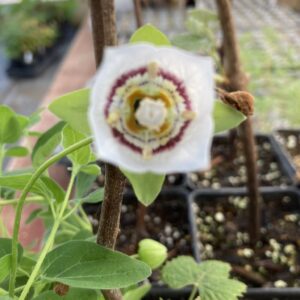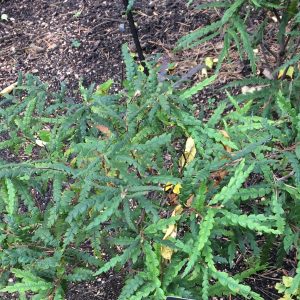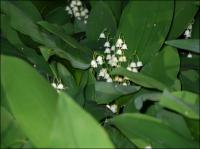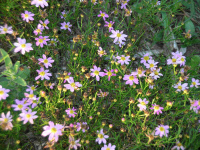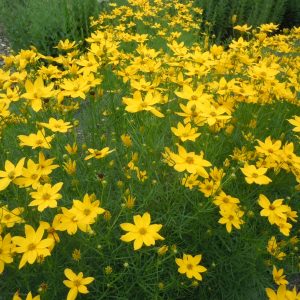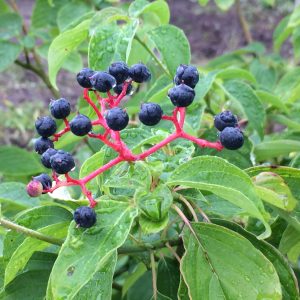Shop
Showing 201–208 of 788 results
-
Cleome serrulata Rocky Mountain Beeweed, Spiderflower, Stinkweed Reseeding annual
Blooming all summer dozens of rose to lilac-colored flowers bunch together at the top of the 3-4” tall stem seemingly one soft-ball sized flower. Thread-thin stamens protrude above the flowers, each flower bearing six stamens, 72, for example, if the cluster contains a mere dozen individual flowers earning it the nickname spider flower. Short leaves grow the length of plant stems, from bottom to top, bare of flowers. A trio of leaflets to each leaf, one as a leader with two sidekicks.
OUT OF STOCK – EMAIL FOR AVAILABILITY
Blooming all summer dozens of rose to lilac-colored flowers bunch together at the top of the 3-4” tall stem seemingly one soft-ball sized flower. Thread-thin stamens protrude above the flowers, each flower bearing six stamens, 72, for example, if the cluster contains a mere dozen individual flowers earning it the nickname spider flower. Short leaves grow the length of plant stems, from bottom to top, bare of flowers. A trio of leaflets to each leaf, one as a leader with two sidekicks.
Size: 4' x 9"
Care: sun in moist-well drained to dry soil, drought tolerant
Native: Minnesota west to the Pacific, south to Arizona and New Mexico and all in between.
Wildlife Value: So many flowers, each with nectar and a hoard of stamens each holding pollen in a soft-ball sized object makes this a mecca for pollinators of all sorts, numerous bee species, wasps and several butterflies. When it’s done flowering birds eat its seeds. Its skunk-like odor (Stinkweed) has one advantage – it keeps the deer away.An ancient, pre-historic plant, Natives including Lakota, Zuni, Tewa, Navajo, and Pueblo found many uses for this Cleome. Some ate shoots, leaves, seeds or flowers, cooked them, or ate them raw alone or together with other food. Tewa grew this with corn, beans and squash to attract pollinators to pollinate the food plants. Infusions treated fever, and stomach aches. A poultice treated sore eyes. Lakota used this and a shrub to trap bison. Navajo color rugs with a yellow-green dye they make from Cleome. Pueblo Indians concentrate Cleome to make a thick, black paste to decorate baskets and pottery. Meriwether Lewis collected three of these two on the way west and one homebound traveling east.
-
Codonopsis ovata syn. Glosocomia ovata syn. Wahlenbergia roylei Kashmir Bellflower, Bonnet Bellflower Z 3-7
Large, single, pendulous, milky-blue bell-shaped flowers flared at the tips. Blooms July-August.
ARCHIVED
Note: This is a plant not currently for sale. This is an archive page preserved for informational use.
Large, single, pendulous, milky-blue bell-shaped flowers flared at the tips. Blooms July-August.
Size: 15” x 15”
Care: sun to part shade in moist well-drained soil
Native: Himalayas, from Pakistan to Kashmir
Wildlife Value: attracts Bees
Size: Root is edible (but not tasty) when cooked. It can also be dried and ground into a powder. A famine food, used when all else fails. The roots and leaves have been used in its native areas to make a poultice for the treatment of bruises, ulcers and wounds. Medicinal use published 1895.Collected before 1835.
-
Comptonia peregrina Sweet Fern Z 2-6 SHRUB
Grown for it’s fern like leaves, this small shrub flowers in spring with insignificant yellow flowers followed by brown nutlets. Foliage is fragrant when crushed.
Grown for its fern like leaves, this small shrub flowers in spring with insignificant yellow flowers followed by brown nutlets. Foliage is fragrant when crushed.
LIMITED QUANTITES AVAILABLE. ONE PER CUSTOMER PLEASE.
Size: 2-5’ x 4’ spreading
Care: sun to part shade in moist, well-drained to well-drained soil. Prefers acidic, but will grow in other types of soil as well. Drought and salt tolerant.
Native: Eastern North America, Wisconsin native
Wildlife Value: Attracts bees, butterflies, & birds. Larval host plant for many moths, including Io moth, several Sphinx moth species, and the Anise Swallowtail butterfly. Deer resistant. Nitrogen fixer.Genus name honors Henry Compton (1632-1713), Bishop of London and patron of botany. Peregrina means exotic or immigrant. Many Native Americans (Algonquin, Cherokee, Chippewa, Delaware, Menominee, Delaware, Potawatomi) used this plant for a wide variety of purposes: Crushed leaves inhaled for headache. Leaf infusions for: round worms, fevers, beverage, blood purifier, blisters, clear mucus from lungs, bladder inflammation, rash from poison ivy, swelling, flux, stomach cramps, itch. Fragrant leaves- burned or crushed for incense in ceremony, perfume, Decoction – childbirth, tonic, Other: sprinkle on medicine to poison enemy, prevent blueberries from spoiling, leaves in fire to make smudge to ward off mosquitoes. Oneida made a tea.
Collected for botany before 1753. Grown at America’s 1st botanic garden, Elgin Botanic Garden 1811.**LISTED AS OUT OF STOCK BECAUSE WE DO NOT SHIP THIS ITEM. IT IS AVAILABLE FOR PURCHASE AT OUR RETAIL LOCATION.
-
Convallaria majalis Lily of the Valley Z 2-7
Classic - dainty alabaster white bells perfume the air in spring. Frangrance unmistakable.
Classic – dainty alabaster white bells perfume the air in spring. Fragrance unmistakable.
Can not ship to: Maryland
Size: 9" x Spreading.
Care: sun to shade in moist or moist well-drained soil.
Native: north temperate zones in the world.
Size: Makes a great groundcover under trees.Convallaria is Latin meaning “valley.” Majalis means “May flowering.” Lily of the valley has been cultivated since at least 1000 B.C. The Norse goddess of dawn adopted it as her special flower. According to legend the plant first appeared at the spot where St. Leonard shed blood while conquering the dragons. Grown in the garden of Johann Konrad von Gemmingen prince bishop of Eichstätt in Bavaria, c. 1600. 17th century herbalists used Lily of the Valley to improve memory and strengthen the heartbeat. Robert Louis Stevenson reported medicinal uses in Kidnapped: “for sprains, rub it in; and for the cholic, a greate spooneful in the hour.” Pink flowered varieties, striped and variegated ones grew in the 1500’s. Grown by Jefferson at Monticello. Pressed specimen in Emily Dickinson’s herbarium.
-
Coreopsis lanceolata Lanceleaf tickseed Z 4-9
Golden yellow daisy-like flowers with pleated petals, jagged at their tips, June to September
OUT OF STOCK
Golden yellow daisy-like flowers with pleated petals, jagged at their tips, June to September
Size: 24” x 18”
Care: sun to part shade, moist well-drained soil
Native: Central and southeastern U.S., WI native
Wildlife Value: caterpillar food sourceCoreopsis is Greek meaning “buglike” referring to the seeds looking like little black bugs. Cultivated in America since the 1700’s. Sent to England in 1724 by English naturalist Mark Catesby (1683-1749).
-
Coreopsis rosea Pink tickseed Z 4-8
Dainty (appearing but actually tough) pink daisies with yellow centers from summer through autumn, very long blooming. Wonderful for rock gardens, groundcover or front of border.
ARCHIVED
Note: This is a plant not currently for sale. This is an archive page preserved for informational use.
Dainty (appearing but actually tough) pink daisies with yellow centers from summer through autumn, very long blooming. Wonderful for rock gardens, groundcover or front of border.
Size: 12” x 12” spreading
Care: full sun in well-drained soil. Slow to emerge in spring.
Native: Eastern No. AmericaCoreopsis is Greek meaning “buglike” referring to the seeds looking like little black bugs. Thomas Nuttall 1st collected this flower in 1815 about 20 miles NW of Savannah along the river. He described its native habitat: “in open grassy swamps from New Jersey to Georgia…” William Robinson, father of the mixed perennial border called this “a neat and pretty plant.” In 1913 Sanders wrote that it “make(s) a brilliant display of color (when) grown in masses in sunny borders.”
-
Coreopsis verticillata Thread leafed tickseed Z 4-9
All summer into fall, free-blooming non-stop - yolk yellow daisies of 8 narrow spoon-shaped petals with a color matching center each atop a wiry stem. Cut back half-way to promote reblooming in fall.
All summer into fall, free-blooming non-stop – yolk yellow daisies of 8 narrow spoon-shaped petals with a color matching center each atop a wiry stem. Cut back half-way to promote reblooming in fall.
Size: 24" x 18" spreading
Care: Sun to part shade well-drained to moist well-drained soil, drought tolerant
Native: S.E. U.S.
Wildlife Value: attracts butterflies, Deer resistantNatives made a tea with the roots to remedy diarrhea and induce vomiting and a tea with the plant tops to make blood strong. A drink made from boiling the entire plant was used to remedy internal pain and bleeding. Also made a red dye and a yellow dye. Exported from its native America to England in 1759.
-
Cornus alternifolia Pagoda dogwood Z 4-7
Small tree with horizontal branches in flat tiers & a flat top, like the roof of a pagoda, bearing fragrant white flowers in early summer & blue berries on red stems against maroon leaves in fall.
Small tree with horizontal branches in flat tiers & a flat top, like the roof of a pagoda, bearing fragrant white flowers in early summer & blue berries on red stems against maroon leaves in fall.
Size: 15-30’ x 15-30’
Care: part shade in moist to moist well-drained soil – great understory tree.
Native: Canada to GA, west to MN – WI native
Wildlife Value: Hosts Spring azure butterfly caterpillar. Both food and shelter for Bluejay, Catbird, Chickadee, Flicker, Grosbeak, Junko, Oriole, Sparrow, Tanager, Thrush, Woodpecker, and food for more than 20 additional birds who eat the fruits.
Awards: Great Plants for Great PlainsAlternifolia means leaves alternating on stem. Cherokee chewed bark for headaches, sore throat, worms, measles & diarrhea. Poltice topically applied on ulcers & a decoction for colds & cough. Collected and described in writing before 1753. Grown at America’s 1st botanic garden, Elgin Botanic Garden 1811.
**LISTED AS OUT OF STOCK BECAUSE WE DO NOT SHIP THIS ITEM. IT IS AVAILABLE FOR PURCHASE AT OUR RETAIL LOCATION.


